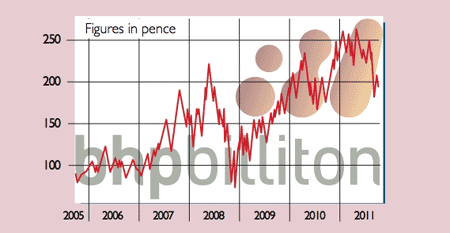
What is BHP Billiton?
BHP Billiton (BLT) is one of the world’s largest natural resources companies. Its business is split across nine areas: petroleum; aluminium; base metals; diamonds and speciality products; stainless steel materials; iron ore; manganese; metallurgical coal; and energy coal.
What is the company’s history?
The company was created by the merger of BHP and Billiton in 2001. Billiton was formed in 1860 when a tin mine was opened on the Indonesian island of Billiton. The company developed into a global leader in aluminium, chrome, manganese, steam coal, nickel and titanium. BHP began life in 1885 with a silver, lead and zinc mine in Broken Hill, Australia. It then went on to develop resources in iron ore, copper, oil and gas, diamonds, silver, lead and zinc. In recent years, BHP Billiton has tried and failed to create a global mining giant. In 2007 it bid for Rio Tinto, and in 2010 it failed in its bid for Potash Corp of Canada. It also failed to merge its iron-ore assets with Rio Tinto’s.
Who runs BHP Billiton?
Marius Kloppers has been CEO since 2007. Previously he was head of the group’s non-ferrous materials business. He was paid $4.4m in 2010. Ex Ford Motor Company CEO Jacques Nasser is chairman and the finance director is Alex Vanselow.
How is trading?
For the year ending June 2011, operating profit increased by 62% to $32bn. Earnings per share increased by 75.6% to $3.94 and the dividend was increased by 16.1% to 101 US cents per share. Iron ore was the star performer, with operating profits increasing by 122% to $13.3bn. Petroleum, base metals and energy coal also posted strong growth. Aluminium was the only disappointment, with profits down 34%. The company maintained its strong financial position. Net debt of $5.8bn means gearing (debt to equity) of only 10%, while interest payments were covered over 42 times by operating profits.
What is the outlook for BHP Billiton?
Profits are highly sensitive to world economic growth and commodity prices. The company remains confident that China and India will drive demand. However, it has cautioned that buoyant prices caused by supply constraints in coal, iron ore, copper and oil are unlikely to continue. Cost pressures are intense in areas such as raw materials, energy and labour, while the devaluation of the dollar isn’t helpful. The firm boasts an $80bn pipeline of development projects out to 2015.
The analysts
Of the 32 analysts surveyed by Bloomberg, 21 say “buy” and 11 “hold”. The average price target is 2,723p – 39% above the current share price. Most bullish is Credit Suisse with a 3,160p price target, whereas Independent Research is most bearish with a 2,050p target. Our view: with the commodities outlook uncertain, even a p/e of 6.4, plus a strong balance sheet and dividend, should only tempt an adventurous investor.
The numbers
Stockmarket code: BLT
Share price: 1,957p
Market cap: £119bn
Net assets (June 2011): $57.8bn
Net Debt (June 2011): $5.8bn
P/E (current year estimate): 6.4x
Yield (prospective): 3.6%
Directors’ dealings
The recent dealings by directors are mostly company share scheme related – deal dates are shown on the chart. From a corporate governance standpoint, BHP Billiton has demanding share ownership guidelines for its main directors. The CEO must hold three times his after-tax salary in shares. Other members of the senior management team must hold twice their after-tax salary.
Director and shares held
MJ Kloppers: 225,000
A Vanselow:* 252,727
A Mackenzie: 12,476
K Rumble: 2,300
M P Randolph:* 200,126
JM Yeager:* 254,877
K Wood:* 198,686
A Calderon: 198,396
J Nasser (ADRs): 24,000
• Transactions on the Australian Stock Exchange